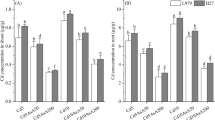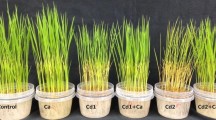Abstract
A hydroponic experiment was carried out to study the physiological mechanisms of N-acetyl cysteine (NAC) in mitigating cadmium (Cd) toxicity in two barley (Hordeum vulgare L.) genotypes, Dong 17 (Cd-sensitive) and Weisuobuzhi (Cd-tolerant). Addition of 200 μM NAC to a culture medium containing 5 μM Cd (Cd + NAC) markedly alleviated Cd-induced growth inhibition and toxicity, maintained root cell viability, and dramatically depressed O ·−2 and ·OH, and malondialdehyde accumulation, significantly reduced Cd concentration in leaves and roots, especially in the sensitive genotype Dong 17. External NAC counteracted Cd-induced alterations of certain antioxidant enzymes, e.g., brought root superoxide dismutase and glutathione reductase, leaf/root peroxidase and glutathione peroxidase activities of the both genotypes down towards the control level, but elevated Cd-stress-depressed leaf catalase in Dong 17 and root ascorbate peroxidase activities in both genotypes. NAC counteracted Cd-induced alterations in amino acids and microelement contents. Furthermore, NAC significantly reduced Cd-induced damage to leaf/root ultrastructure, e.g. the shape of chloroplasts in plants treated with Cd + NAC was relatively normal with well-structured thylakoid membranes and parallel pattern of lamellae but less osmiophilic plastoglobuli compared with Cd alone treatment; nuclei of root cells were better formed and chromatin distributed more uniformly in both genotypes. These results suggested that under Cd stress, NAC may protects barley seedlings against Cd-induced damage by directly and indirectly scavenging reactive oxygen species and by maintaining stability and integrity of the subcellular structure.





Similar content being viewed by others
Abbreviations
- APX:
-
Ascorbate peroxidase
- CAT:
-
Catalase
- Cd:
-
Cadmium
- GPX:
-
Glutathione peroxidase
- GR:
-
Glutathione reductase
- GSH:
-
Reduced glutathione
- MDA:
-
Malondialdehyde
- NAC:
-
N-acetyl cysteine
- O ·−2 :
-
Superoxide radical
- ·OH:
-
Hydroxyl radical
- PBK:
-
Potassium phosphate buffer
- PBS:
-
Sodium phosphate buffer
- POD:
-
Guaiacol peroxidase
- ROS:
-
Reactive oxygen species
- SOD:
-
Superoxide dismutase
- SPAD:
-
Soil plant analysis development
- TBA:
-
Thiobarbituric acid
References
Aspinall D, Paleg LG (1981) Proline accumulation: physiological aspects. In: Paleg LG, Aspinall D (eds) The physiology and biochemistry of drought resistance in plants. Academic Press, Sydney, pp 215–228
ATSDR (2008) Draft toxicological profile for cadmium. US Department of Health and Human Services, Atlanta
Cai Y, Cao FB, Cheng WD, Zhang GP, Wu FB (2011) Modulation of exogenous glutathione in phytochelatins and photosynthetic performance against Cd stress in the two rice genotypes differing in Cd tolerance. Biol Trace Elem Res 143:1159–1173
Chen F, Dong J, Fang W, Wu FB, Zhang GP, Li GM, Chen ZF, Chen JX, Wei K (2007) Identification of barley genotypes with low grain Cd accumulation and its interaction with four microelements. Chemosphere 67:2082–2088
Chen DW, Wang L, Cao J, Zhang Y, Liu ZP (2008a) Protective effect of N-acetylcysteine against oxidative damage caused by cadmium on kidney cortex of rat. Chin J Vet Sci 38(11):968–972
Chen F, Wang F, Zhang GP, Wu FB (2008b) Identification of barley varieties tolerant to cadmium toxicity. Biol Trace Elem Res 121:171–179
Chen DW, Wang L, Cao J, Zhang Y, Liu ZP (2010a) Protective effect of N-acetyl cysteine on renal function damage induced by exposed to cadmium in drinking water in rats. Chin J Vet Sci 30(2):250–253
Chen F, Wang F, Wu FB, Mao WH, Zhang GP, Zhou MX (2010b) Modulation of exogenous glutathione in antioxidant defense system against Cd stress in the two barley genotypes differing in Cd tolerance. Plant Physiol Biochem 48:663–672
Cho UH, Seo NH (2005) Oxidative stress in Arabidopsis thaliana exposed to cadmium is due to hydrogen peroxide accumulation. Plant Sci 168:113–120
Costa G, Morel JL (1994) Water relations, gas exchange and amino acid content in Cd-treated lettuce. Plant Physiol Biochem 32:561–570
De Flora S, Izzotti A, D’Agostini F, Balansky RM (2001) Mechanisms of N-acetylcysteine in the prevention of DNA damage and cancer, with special reference to smoking related end-points. Carcinogenesis 22:999–1013
Demir EO, Cakmak GK, Bakkal H, Turkcu UO, Kandemir N, Demir AS, Tascılar O (2011) N-acetyl-cysteine improves anastomotic wound healing after radiotherapy in rats. J Invest Surg 24(4):151–158
Deng XP, Xia Y, Hu W, Zhang HX, Shen ZG (2010) Cadmium-induced oxidative damage and protective effects of N-acetyl-l-cysteine against cadmium toxicity in Solanum nigrum L. J Hazard Mater 180(1–3):722–729
Díaz-Cruz MS, Mendieta J, Tauler R, Esteban M (1997) Cadmium-binding properties of glutathione: a chemometrical analysis of voltammetric data. J Inorg Biochem 66:29–36
Drotar A, Phelps P, Fall R (1985) Evidence for glutathione peroxidase activities in cultured plant cells. Plant Sci 42:35–40
Fridovich I (1986) Biological effects of superoxide radical. Arch Biochem Biophys 247:1–11
Fukutoku Y, Yamada Y (1981) Diurnal changes in water potential and free amino acid contents of water-stressed and nonstressed soybean plants. Soil Sci Plant Nutr 27:195–204
Garcia-Limones C, Hervas A, Navas-Cortes JA, Jimenez-Diaz RM, Tena M (2002) Induction of an antioxidant enzyme system and other oxidative stress markers associated with compatible and incompatible interactions between chickpea (Cicer arietinum L.) and Fusarium oxysporum f. sp. ciceris. Physiol Mol Plant Pathol 61:325–337
Jalilehvand F, Amini Z, Parmar K, Kang EY (2011) Cadmium(II) N-acetylcysteine complex formation in aqueous solution. Dalton Trans 40:12771–12778
Kastori R, Petrovic M, Petrovic N (1992) Effect of excess lead, cadmium, copper and zinc on water relations in sunflower. J Plant Nutr 15:2427–2439
Kelly GS (1998) Clinical applications of N-acetylcysteine. Altern Med Rev 3:114–127
Kosower NS, Kosower EM (1978) The glutathione status of cells. Int Rev Cytol 54:109–160
Lima AIG, Pereira SIA, de Almeida Paula Figueira EM, Caldeira GCN, de Matos Caldeira HDQ (2006) Cadmium detoxification in roots of Pisum sativum seedlings: relationship between toxicity levels, thiol pool alterations and growth. Environ Exp Bot 55:149–162
Mah V, Jalilehvand F (2009) Cadmium(II) complex formation with glutathione. J Biol Inorg Chem. doi:10.1007/s00775-009-0616-3
Matés JM (2000) Effects of antioxidant enzymes in the molecular control of reactive oxygen species toxicology. Toxicology 153:83–104
Munns R, Brady CJ, Barlow EER (1979) Solute accumulation in the apex and leaves of wheat during water stress. Aust J Plant Physiol 6:379–389
Nagoor Meeran MF, Mainzen Prince PS, Basha RH (2012) Preventive effects of N-acetyl cysteine on lipids, lipoproteins and myocardial infarct size in isoproterenol induced myocardial infarcted rats: an in vivo and in vitro study. Eur J Pharmacol 677:116–122
Nakano Y, Asada K (1981) Hydrogen peroxide is scavenged by ascorbate-specific peroxidase in spinach chloroplasts. Plant Cell Physiol 22:867–880
Rauser WE, Meuwly P (1995) Rentention of cadmium in roots of maize seedlings—role of complexation by phytochelatins and related thiol peptides. Plant Physiol 109:195–202
Romero-Puertas MC, Rodríguez-Serrano M, Corpas FJ, Gómez M, Del Río LA, Sandalio LM (2004a) Cadmium-induced subcellular accumulation of O2·− and H2O2 in pea leaves. Plant Cell Environ 27:1122–1134
Romero-Puertas MC, Perazzolli M, Zago ED, Delledonne M (2004b) Nitric oxide signalling functions in plant–pathogen interactions. Cell Microbiol 9:795–803
Sanita di Toppi L, Gabbrielli R (1999) Response to cadmium in higher plants. Environ Exp Bot 41:105–130
Santosh P, Ansuman C, Shelley B, Manas RR, Anindita C (2011) Fluoride-induced genotoxicity in mouse bone marrow cells: effect of buthionine sulfoximine and N-acetyl-L-cysteine. J Appl Toxicol 31:618–625
Schützendubel A, Schwanz P, Teichmann T, Gross K, Langenfeld-Heyser R, Godbold DL, Polle A (2001) Cadmium-induced changes in antioxidative systems, hydrogen peroxide content, and differentiation in Scots pine roots. Plant Physiol 127:887–898
Shanker AK, Sudhagar R, Pathmanabhan G (2001) Growth, phytochelatin SH and antioxidative response of sunflower as affected by chromium speciation. 2nd international congress of plant physiology on sustainable plant productivity under changing environment. New Delhi, India
Somashekaraiah BV, Padmaja K, Prasad AK (1992) Phytotoxicity of cadmium ions on germinating seedlings of mung bean (Phaseolus vulgaris), involvement of lipid peroxides in chlorophyll degradation. Physiol Plant 85:85–89
Uraguchi S, Fujiwara T (2012) Cadmium transport and tolerance in rice: perspectives for reducing grain cadmium accumulation. Rice 5:5
Wang AL, Wang JP, Wang H (2006) A dual effect of N-acetylcysteine on acute ethanol-induced liver damage in mice. Hepatol Res 34:199–206
Wu FB, Zhang GP (2002) Genotypic differences in effect of Cd on growth and mineral concentrations in barley seedlings. Bull Environ Contam Toxicol 69:219–227
Wu FB, Zhang GP, Dominy P (2003) Four barley genotypes respond differently to cadmium: lipid peroxidation and activities of antioxidant capacity. Environ Exp Bot 50:67–78
Wu FB, Chen F, Wei K, Zhang GP (2004) Effect of cadmium on free amino acid, glutathione and ascorbic acid concentrations in two barley genotypes (Hordeum vulgare L.) differing in cadmium tolerance. Chemosphere 57:447–454
Yamada M, Ueno T, Minamikawa H, Sato N, Iwasa F, Hori N, Ogawa T (2010) N-acetyl cysteine alleviates cytotoxicity of bone substitute. J Dent Res 89(4):411–416
Zembron-Lacny A, Slowinska-Lisowska M, Szygula Z, Witkowski K, Szyszka K (2009) The comparison of antioxidant and haematological properties of N-acetylcysteine and α-lipoic in physically active males. Physiol Res 58:855–861
Yang SF, Hoffman NE (1984) Ethylene biosynthesis and its regulation in higher plants. Annu Rev Plant Physiol 35:155–189
Zhang XZ (1992) The measurement and mechanism of lipid peroxidation and SOD, POD and CAT activities in biological system. In: Zhang XZ (ed) Research methodology of crop physiology. Agriculture Press, Beijing, pp 208–211
Zhang F, Li X, Wang C, Shen Z (2000) Effect of cadmium on autoxidation rate of tissue and inducing accumulation of free proline in seedlings of mung bean. J Plant Nutr 23:356–368
Acknowledgments
This work was supported by the National Natural Science Foundation of China (30571097, 31071365), the National 863 program (2012AA101105), the PhD Programs Foundation of Ministry of Education of China (J20120066), and the Key Research Foundation of Science and Technology Department of Zhejiang Province of China (2012C12902-2).
Author information
Authors and Affiliations
Corresponding author
Electronic supplementary material
Below is the link to the electronic supplementary material.
Rights and permissions
About this article
Cite this article
Sun, H., Zhang, X., He, X. et al. N-acetyl-cysteine alleviates Cd toxicity and reduces Cd uptake in the two barley genotypes differing in Cd tolerance. Plant Growth Regul 74, 93–105 (2014). https://doi.org/10.1007/s10725-014-9906-z
Received:
Accepted:
Published:
Issue Date:
DOI: https://doi.org/10.1007/s10725-014-9906-z




